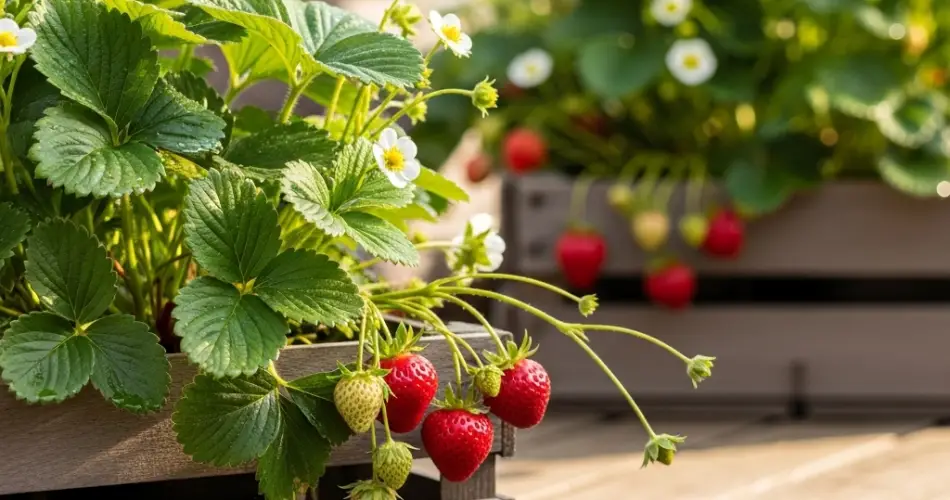There’s something special about picking fresh, sun-warmed strawberries right from your own backyard. Their sweet flavor, vibrant color, and fragrant aroma make them a favorite among home gardeners. Even if you don’t have space for a traditional garden bed, you can still enjoy an abundant harvest by growing strawberries in wooden crates.
This method is not only space-efficient but also decorative, making it perfect for patios, balconies, and small yards. With the right preparation, soil mix, and care routine, your crate-grown strawberries can thrive and produce delicious fruit all season long.
Why Grow Strawberries in Crates?
Wooden crates offer several advantages over planting in the ground or standard pots:
-
Space-saving – Ideal for small gardens or urban settings.
-
Improved soil control – You choose the perfect soil mix for healthy roots.
-
Better drainage – Prevents waterlogging, which strawberries dislike.
-
Portability – Move crates to follow sunlight or shelter from extreme weather.
-
Aesthetic appeal – Adds a rustic, charming look to your outdoor space.
By elevating the plants, crates also make harvesting easier and help protect the berries from pests and soil-borne diseases.
Choosing Strawberry Varieties
Select a variety that matches your growing climate and desired harvest pattern:
-
June-bearing – Produce a single, large crop in early summer.
-
Everbearing – Offer two main harvests, one in early summer and another in late summer.
-
Day-neutral – Produce fruit steadily from spring to fall in mild climates.
For crate growing, day-neutral or everbearing varieties often provide the most continuous yield, especially for small-space gardeners.
Preparing the Wooden Crate
Choose a sturdy crate that’s at least 12 inches deep to accommodate root growth. Make sure it’s untreated wood to avoid chemical contamination.
Steps to prepare the crate:
-
Line it – Use landscape fabric or burlap to keep soil in place while allowing excess water to drain.
-
Ensure drainage – Drill holes in the bottom if none are present to prevent root rot.
-
Elevate if possible – Place the crate on bricks or pot feet to improve airflow underneath and further reduce moisture buildup.
Creating the Perfect Soil Mix
Strawberries prefer loose, fertile, and well-draining soil. A good mix for crate planting includes:
-
40% high-quality garden soil
-
40% compost or well-rotted manure
-
20% coarse sand or perlite for drainage
Mix in a slow-release organic fertilizer before planting to give your strawberries a strong start.
Planting Strawberries in Crates
Plant crowns so that the base of the plant is just above soil level — burying too deep can cause rot, while planting too shallow can dry out roots.
-
Spacing – Place plants 8–10 inches apart to allow for spreading runners.
-
Arrangement – For a rustic look, stagger plants so leaves cascade over the edges of the crate.
Water immediately after planting to settle the soil around the roots.
Watering and Mulching
Strawberries need consistently moist soil, but they don’t tolerate soggy roots. Crates dry out faster than garden beds, so check moisture daily in hot weather.
-
Watering tip – Water at the base of plants to avoid wetting leaves, which can encourage disease.
-
Mulching – Apply straw, pine needles, or shredded leaves around the plants to retain moisture, suppress weeds, and keep fruit clean.
Sunlight and Temperature
Strawberries need 6–8 hours of direct sunlight daily to produce abundant, sweet fruit. Position crates in a sunny location, and if possible, rotate them every few days for even exposure.
In hot climates, consider moving crates to a slightly shaded area during the peak of summer to prevent heat stress.
Feeding Your Strawberries
Because crate soil nutrients can deplete quickly, supplement with fertilizer during the growing season:
-
Use a balanced organic fertilizer every 4–6 weeks.
-
Switch to a phosphorus-rich blend when plants begin flowering to encourage fruit production.
Managing Runners
Strawberries send out runners that can root and form new plants. Decide whether you want to let them spread or prune them to focus the plant’s energy on producing fruit. For crate gardening, it’s often better to remove most runners to maintain space and encourage larger berries.
Pest and Disease Control
While crates reduce certain pests, strawberries can still attract birds, slugs, and insects:
-
Bird protection – Use netting or row covers once berries begin ripening.
-
Slug prevention – Keep mulch dry and use crushed eggshells around plants.
-
Air circulation – Space plants properly to prevent fungal issues.
Harvesting Your Strawberries
Pick berries when they’re fully red and firm, ideally in the morning when they’re cool. Regular harvesting encourages continued fruiting and prevents overripe berries from attracting pests.
Handle strawberries gently, as they bruise easily. Eat them fresh, or store unwashed in the refrigerator for up to three days.
End-of-Season Care
After the harvest season:
-
Remove old or damaged leaves.
-
Top up the soil with compost.
-
In cold climates, move crates to a sheltered spot or insulate them with straw to protect plants over winter.
With proper care, your strawberry plants can produce for several years before needing replacement.
Final Thoughts
Growing strawberries in wooden crates combines beauty, practicality, and productivity. This method gives you the freedom to garden in limited spaces while enjoying the freshness of homegrown fruit. With the right variety, soil preparation, and attentive care, you’ll have baskets of sweet, juicy strawberries to enjoy throughout the season — and the satisfaction of knowing they came from your own backyard.



